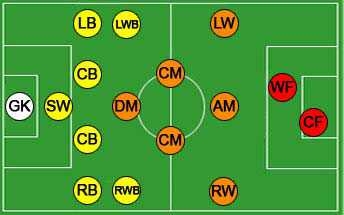Football News: Midfielders - Part 3

Image from: football-bible.com
Midfielders - Part 3
Onto the third and final part: the attacking midfielders. Those who mainly operate in the area behind the forwards.
Firstly the most attacking type, the Italians would call it the Trequartista, it is often known as a second striker or even a number 10. It is very much a role that is almost a striker, in days gone by the likes of Dennis Bergkamp and Kenny Dalglish, who very much played this role, were considered forwards, nowadays they are considered attacking midfielders. Probably because they are often asked to drop in and help defend when the ball is lost, unlike in the past when they were generally given freedom to do what they wanted.
They are there to provide and score goals, almost caught between two stools, not really a goalscorer but often not the team's playmaker any more, unlike the Dalglish and Bergkamp days, when the second striker was the key role. Now they can often be usurped in importance outside of Italy, where the Francesco Tottis still exist. For instance you have Dele Alli in the Tottenham Hotspur team who often plays this role, but his importance is secondary or even tertiary behind the goalscorer Harry Kane and playmaker Christian Eriksen.
It is one of the most specialised positions in the game, mainly because so few teams will carry a passenger unlike in the past, so they are expected to work back as well as getting forward. That makes this a very difficult role to fulfil, as players have to ensure they are not arriving in the box on the back of a lung bursting run that leaves them too busy gasping for air to hit the shot properly.
The most common and obvious type is the advanced playmaker, the David Silva (or Bernardo Silva), Philippe Coutinho, Juan Mata and Dmitri Payet type. Often these players are used in wide positions, with license to cut inside, but they are at their best, usually, when just given freedom to play where they like. While they usually have the skills to dribble past opponents and a good shot on them, that is not what they are really all about.
They can be magical to watch, with their quick feet and lovely range of passing as they sit at the heart of everything the team does. The ball seems to have a magical attraction to their feet at times as their teammates constantly look to play the ball to them. They can also be maddeningly lacking in workrate if allowed to be. What they do on the ball is what matters most though. Watching a player like David Silva is a joy to behold.
The main difference between them and the more deep lying playmakers is that they operate in less space and their passes tend to be threaded through tight gaps, rather than big, long range passes. Their game is, by necessity, more intricate, and so involves a totally different skillset of passes than the deeper player. The deeper player is looking for a space to play a ball into, the advanced playmaker is looking for a runner to pass to. Being in and around the penalty box space is at a premium and the ball needs to be pinpoint with the right weight.
It is waiting for the right moment to release the ball that is usually when quick feet and the ability to beat a man is most effective. Rather than just playing a pass, they can hold onto it waiting for the right run to play the ball into.
Players playing in the attacking midfield area are not only there to play an attacking role, as has been demonstrated a number of times last season, when Jose Mourinho deployed Marouane Fellaini in an attacking midfield position for a wholly defensive purpose. His job was to close off the space a deep lying playmaker needs to operate at their best. He also offered the ability to play another role, when Man Utd had possession of the ball - the target man.
The target man is usually an out and out striker playing right up against the defenders, but a deeper one has its uses too, in fact can often be even more effective there. For starters the competition for the ball is midfielders, rather than centre backs, so the big Fellaini-type has an advantage in the air. Centre backs are usually amongst the best players in the air, so dropping him off them and into the space between them and the midfield will usually give a major edge to the target man.
More than that, it gives them more options on the ball, as they are able to flick it on knowing there is almost certainly someone up ahead of them, while still being able to provide an out ball to a defence under pressure. Being deeper also gives them an easier ball to control, as it has not been hit with such power that it is difficult to trap with the chest or control a header.
One final type is the runner, the Eden Hazard-type, who will look to use pace and trickery to create chances, rather than incisive passing. They want the ball at their feet on the run, they want to attack the defence, dribbling round opponents, drawing men to them to create space for others. They are not always pacey, but they are tricky and it is all about running with the ball. Like the advanced playmaker they are often wide players, Lallana is another good example of this type of player, it is all about twinkletoes.
They usually add their fair share of goals, but it is as much about what they create and how many players they can draw out of position to leave space for others.
Written by Tris Burke November 03 2017 03:40:53


